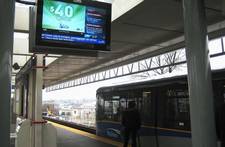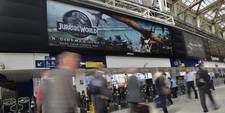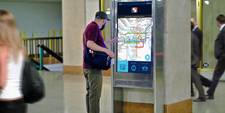We’re on the precipice of a transit revolution, with autonomous vehicles and alternative forms of transportation coming to change the way we get from place to place. That isn’t the whole story, though; existing transit networks will be undergoing transformations of their own.
A big part of this transformation will involve incorporating digital media and information technology to make transit smarter, more efficient, and more adaptable to everyday challenges. Already around the globe, digital signage has proven a useful tool in this transition toward better transit services.
Digital signage can provide up-to-the-minute service updates
Who in the transit-using public has not had to deal with unexplained and unexpected delays or adjustments while on a given route? Big city transit networks are vast webs of intersecting transit lines, and a given passenger will likely understand that delays and breakdowns will occur sometimes. That doesn’t mean that transit networks can’t do more to take some of the stress out of these moments when they happen.
In-station, in-shelter, and in-vehicle signage all offer great opportunities for taking the sting out of surprise service alterations or outages. Networks can use screens to display instant service updates, or even convenient alternatives that passengers might find useful. Not only might this type of move be helpful to passengers, but it might even help alleviate congestion once the affected line is back in motion.
Example: Washington’s Metro Rail system uses digital signage to distribute messages about current and upcoming service alterations, helping passengers better plan their travels.
It can help passengers board more efficiently
Along train and subway platforms, crowds often group to wait for and board their vehicles unevenly. As this process repeats station after station, the result can be dramatic differences in the fullness and comfort of cars along the vehicle. There can even be delays as waiting boarders discover their nearest car is full and have to go down to a car with more free space.
Some transit networks have brought digital signage into the mix to solve this problem. On-vehicle sensors gauge the fullness of individual cars, information which is then presented to those waiting to board on a screen that runs the length of the train. With this notice, passengers have added time to find a more comfortable and efficient place to board the train.
Example: In the Netherlands, ProRail installed signage that indicated train fullness and the locations of embarking points when trains come to a start, helping to promote more comfortable rides and more efficient boarding.
Digital signage is great for delivering interesting content
Yes, these days, just about everybody has access to on-demand audio and video everywhere they go—as long as there’s WiFi or data, and enough battery to see them through their commute. Still, enough people are standing idle, or enjoying audio content only, that delivering some quality video content can be a welcome diversion. Besides, larger screens such as those found in bus shelters, subway stations, and train terminals deliver the kind of visual impact that turns heads, phones or not.
What kinds of content are transit networks displaying? News, weather, and sports are common fixtures, but it’s easy to branch out into more diverse kinds of content, too. Box office info, lifestyle tips, and trivia and other games are all fun additions that can capture attention and make transit a little livelier. Best of all, content providers like Screenfeed make it easy to get high-quality, locally relevant content onto digital screens. It doesn’t take much work to make commuters’ trips a little more engaging.
Example: Vancouver’s TransLink network uses digital signage to deliver news, weather, and diverting content to passengers waiting for their ride.
Digital out-of-home ads in transit connects riders with brands they love
Advertising is an important revenue stream for many transit networks, and digital displays grant unique flexibility to pursue this revenue. Between playing different ads at different times of day, triggering content in response to conditions like weather or platform-crowdedness, or delivering takeover campaigns across all the displays in an area, more can be done with digital advertising for transit networks.
Particularly now that programmatic advertising is catching on in the out-of-home space, there’s more demand among advertisers for opportunities to reach masses of people using DOOH. Enabling dynamic content delivery by connecting digital signage to external data feeds and audience measurement tools can help transit networks unlock the full value of their screens and deliver ads audiences want to see.
Example: JCDecaux maintains digital displays in Waterloo Station (UK), which can be used to display advertising for media and brands that passers-by enjoy.
Interactive signage enables far better wayfinding
For visitors, infrequent travellers, and people taking a new route for the first time, it’s not always apparent which direction of a line is the right one to take. The results are often stress, missed connections, and frustration with the lack of clarity of the transit network’s signage.
Digital signage offers the chance to take this confusion out of a passenger’s day. By implementing interactive wayfinding terminals at transit shelters and stations, transit networks can put personalized directions in the hands of individual passengers who need to know. Smart little tweaks of design, like using the passenger’s current point of view to orient the onscreen directions, and offering multiple connection options to assist in getting to the destination, can help turn direction seeking from something frantic to something that delivers immediately useful information.
Example: In Philadelphia’s Suburban Station, Intersection delivers personalized wayfinding, along with free WiFi, device charging, and information services through interactive digital signage kiosks.
Going forward, the trend is toward more mass transit networks adopting technology to connect with passengers and deliver a better transit experience. Thanks to strong visual appeal, diversity of uses, and intuitive operation, digital signage is likely to play an important role in this ongoing shift.
Are you looking for a platform to power better transit signage?
See how Broadsign can transform your network.
Featured image: Oslo Station, Norway. Part of JCDecaux’s digital signage network.











